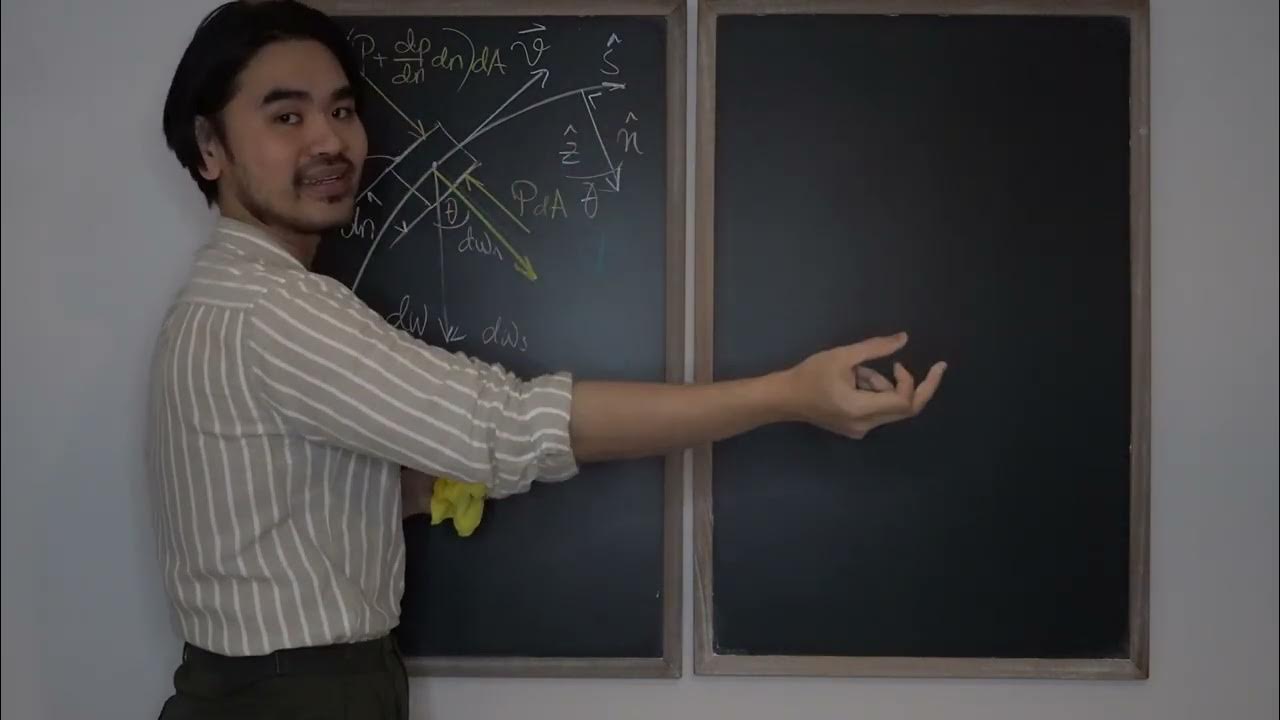Mekanika Fluida FM01 (Lecture2: 2/4). Variation of Hydrostatic Pressure
Summary
TLDRIn this video script, the discussion revolves around fluid pressure variations within a non-moving fluid, specifically addressing the effects of gravity and fluid depth. The speaker introduces the concept by relating it to common experiences, such as the discomfort in ears when diving into water. The script explains the mathematical representation of pressure variation due to fluid weight and gravity. It also touches on key principles like hydrostatic pressure, pressure distribution in fluids at different depths, and how the shape of a container doesn't affect the pressure at a given height. The concepts are explained with relatable examples and visual aids.
Takeaways
- 😀 The variation of pressure in a stationary fluid is influenced by the weight of the fluid above a given point.
- 😀 Pressure increases with depth, as seen when diving deeper into water or a pool, where the pressure on the ears increases with depth.
- 😀 The concept of pressure variation can be understood intuitively by considering the weight of the fluid column above a point in a fluid.
- 😀 The equation for pressure variation in a fluid involves the fluid density (ρ), gravity (g), and the height (h) from the reference point.
- 😀 In a static fluid, the change in pressure (dp) with respect to height (dh) is related to the product of density, gravity, and height.
- 😀 The force acting on a small cubic volume of fluid is analyzed by considering forces from both above and below, including gravitational force and pressure differences.
- 😀 When considering a small cube in a fluid, the pressure from below is caused by the pressure at the point below the cube, while the pressure from above is determined by the pressure at the point above the cube.
- 😀 The total forces on the cube must balance in a static fluid, leading to a zero net force and the simplification of the pressure variation equation.
- 😀 The pressure in a fluid depends on the height from the surface or a reference point, and this relationship is independent of the fluid's shape or geometry.
- 😀 The pressure at a given depth in a fluid is the sum of the atmospheric pressure and the weight of the fluid column above it, which is represented mathematically as P = P_atm + ρgh.
Q & A
What is the main concept being discussed in the transcript?
-The transcript discusses the variation of pressure in a fluid at rest, focusing on how depth and the weight of the fluid contribute to changes in pressure. It also explores how gravitational force affects fluid pressure.
How does pressure vary as we dive deeper underwater, according to the script?
-Pressure increases as you dive deeper underwater due to the increasing weight of the fluid above you. For example, the pressure experienced in your ears while diving is related to the depth you reach.
What is the relationship between pressure and fluid depth described in the transcript?
-The pressure at a given point in a fluid increases with the depth. This relationship is due to the weight of the fluid above that point, which is influenced by the fluid's density and the gravitational force acting on it.
What does the speaker mean by 'fluid at rest'?
-A 'fluid at rest' refers to a situation where the fluid is not moving, and therefore, the forces acting on it are in equilibrium. This allows for the study of how pressure varies due to gravity and depth.
How does gravity affect pressure in a fluid?
-Gravity plays a crucial role in pressure variation in a fluid. The pressure at a given depth is proportional to the density of the fluid, the gravitational acceleration, and the depth itself.
What is the significance of the term 'hydrostatic equilibrium' in the context of this discussion?
-'Hydrostatic equilibrium' refers to the condition where the forces acting on a fluid at rest balance out. In the transcript, the forces from the weight of the fluid and the pressure from the surrounding fluid are balanced, meaning the fluid is in equilibrium.
What equation is derived in the script to describe the pressure variation with depth?
-The equation derived in the script is: DP = -ρg Δh, where DP is the change in pressure, ρ is the fluid density, g is the acceleration due to gravity, and Δh is the change in height or depth.
Why does the script mention the use of an 'imaginary cube' in the analysis?
-The 'imaginary cube' is used to help visualize and analyze the forces acting on a fluid element in the system. By considering the forces on this cube, the speaker explains how pressure variation occurs in a fluid at rest.
How does the pressure change with respect to atmospheric pressure in a fluid?
-The pressure in the fluid is the sum of the atmospheric pressure and the pressure due to the fluid's weight. As the depth increases, the pressure increases due to the weight of the fluid above, and it can be expressed as: P = P_atm + ρgΔh.
What is the intuitive explanation for the pressure increase when diving deeper into a fluid?
-The pressure you feel while diving deeper is a result of the weight of the fluid above you. The deeper you go, the more fluid is above, which means the weight (and thus the pressure) increases.
Outlines

This section is available to paid users only. Please upgrade to access this part.
Upgrade NowMindmap

This section is available to paid users only. Please upgrade to access this part.
Upgrade NowKeywords

This section is available to paid users only. Please upgrade to access this part.
Upgrade NowHighlights

This section is available to paid users only. Please upgrade to access this part.
Upgrade NowTranscripts

This section is available to paid users only. Please upgrade to access this part.
Upgrade NowBrowse More Related Video
5.0 / 5 (0 votes)





